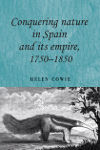Publications

Take a closer look at some of the publications produced by staff at the Centre for the Americas.
The Plough that Broke the Steppes
This is the first environmental history of Russia's steppes. analyses how naturalists and scientists came to understand the steppe environment, including the origins of the fertile black earth. The story is similar to the Dust Bowl on the Great Plains of the USA, which share a similar environment and environmental history. David Moon places the environmental story of the steppes in the wider context of the environmental history of European colonialism around the globe.
Prof Moon was awarded the Alexander Nove Prize in Russian, Soviet and Post-Soviet Studies for this book.
Destined for a Life of Service
Henrice Altink's latest book examines the construction of black womanhood in Jamaica between 1865 and 1938.
Based on a wide range of original sources, including folktales, anthropological studies, court statements, poety and speeches, it sheds new light on the struggle of people of African descent for full and equal citizenship in the post-emancipation British Caribbean.
Conquering Nature in Spain and its Colonies
Between 1750 and 1850, Spain made a concerted effort to survey, catalogue and exploit the natural productions of its overseas possessions, arranging a series of scientific expeditions, and cultivating and displaying American fauna and flora in metropolitan gardens and museums.
Taking a transatlantic approach to the history of science, Conquering Nature by Helen Cowie examines the contribution of colonial subjects to the wider imperial research project.

Recent articles from the YCA
- Altink, Henrice, "Facilitator or hindrance to social change? The Westminster model and racial discrimination on the Jamaican labour market, 1944–1980.", Commonwealth & Comparative Politics, 53, no. 1 (2015).
- Altink, Henrice, ‘‘'Fight TB with BCG': Mass vaccinations in the British Caribbean, 1951-56." Medical History 58, no. 4 (2014): 475-97.
- Black, Lawrence. "From the Great Society to giant: Esther Peterson and the politics of shopping." In Shopping for Change: Consumer Activism in North American History, edited by Joseph Tohill and Louis Hyman, Toronto, forthcoming.
- Black, Lawrence. "Bowling together? Post-war consumer organisations in the USA and UK, a comparative history". In Affluence and Activism: Organised Consumers in the Postwar Era, edited by Iselin Theien and Evan Lange, Oslo: Oslo Academic Press, 2004.
- Cowie, Helen. Exhibiting Animals in Nineteenth-Century Britain: Empathy, Education, Entertainment. Basingstoke: Palgrave Macmillan, 2014.
- Cowie, Helen and Gray, Kathryn, "Nature, nation and nostalgia: Narratives of natural history in Spanish and British America (1750-1800)", Journal for Eighteenth-Century Studies 36, no. 4 (2013): 545-58.
- Huyssen, David, “Labor and Class in the GAPE: Fruitful Opposition and the Specter of the Middle Class.” In A Companion to the Gilded Age and Progressive Era, edited by Christopher M. Nichols and Nancy C. Unger. Wiley-Blackwell: forthcoming February 2017.
- Huyssen, David, “From Socialism to Hedge Fund: The ‘Human Element’ and the ‘New History ofCapitalism.’” Journal of World-Systems Research 21(2), 288-312.
- Moon, David, "Plowing up the world’s grasslands, c.1850", Global Environment, 11 (2013): 207-09.
- Moon, David. "The grasslands of North America and Russia". In A Companion to Global Environmental History, edited by J. R. McNeill and Erin Stewart Maudlin, Oxford: Wiley-Blackwell, 2012, 247-62.
- Moon, David, "In the Russians’ steppes: The introduction of Russian wheat on the Great Plains of the United States of America", Journal of Global History, 3 (2008): 203-25.
Progressive Inequality
David Huyssen's Progressive Inequality tells stories of rich and poor New Yorkers colliding from 1890 to 1920 in contexts that range from urban reform and architectural design to employer violence and mob action.
Rather than delivering contiguous narratives of bourgeois or working-class experience, these stories re-frame U.S. class history as a set of interwoven encounters and ideas, revealing clear continuities in U.S. class relations over time.


